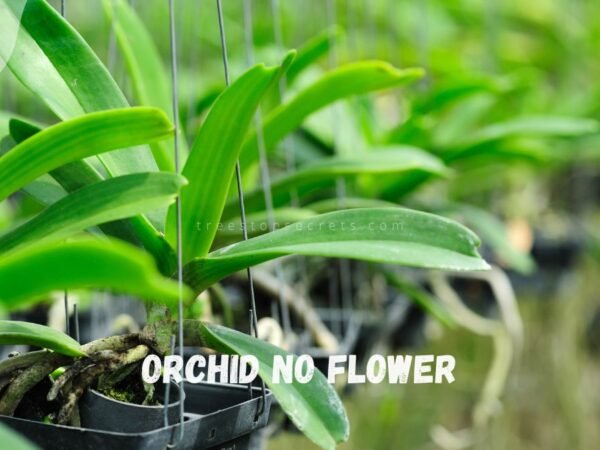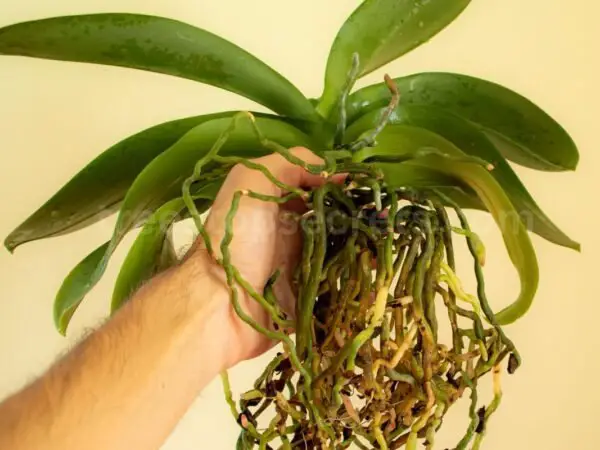Caring for moth orchids can be a delightful journey or a frustrating struggle, all depending on how you water them. Finding the right balance is crucial; too much or too little water can spell disaster for these delicate plants. In this guide, we'll walk through the dos and don'ts of watering your moth orchids indoors, demystifying the process so you can watch them thrive.
Understanding when and how to water your moth orchids is like finding the perfect rhythm in a dance – it's about timing and finesse. We'll explore practical tips on assessing moisture levels, selecting suitable watering methods, and creating an optimal environment for these enchanting flowers to flourish.
Key Takeaways
-
Moth orchids, or Phalaenopsis orchids, require specific light, water drain, and care method to thrive.
-
Ideal Conditions for Moth Orchids: Providing the right environment, including proper light and temperature, is crucial for the health of moth orchids.
-
Watering Phalaenopsis Orchids: Understanding the unique watering needs and light conditions of moth orchids is essential to prevent overwatering or underwatering.
-
Determining Watering Needs: Assessing the moisture levels in the growing medium and the orchid's roots, as well as the light, helps in determining when to water moth orchids.
-
The Watering Process: Proper watering techniques, such as using room-temperature water and avoiding wetting the leaves, contribute to the well-being of moth orchids.
-
Avoiding Common Mistakes: Being mindful of common watering mistakes, like using the wrong type of water or container, is crucial for the overall health of moth orchids.
Understanding Moth Orchids
Understanding Moth Orchids
Moth orchids, belonging to the Phalaenopsis genus, are renowned for their graceful, arching sprays of blooms. Their slow growth rate allows them to thrive for many years when given proper care. These elegant orchids have secured a top spot among enthusiasts due to their stunning and long-lasting flowers.
Their popularity stems from being low-maintenance and adaptable to indoor environments. The wide range of colors and patterns they come in adds to their allure.Moth orchids thrive in bright, indirect light but should be shielded from direct sunlight.
Insufficient light can result in poor flowering and weak growth.
Moth orchids' adaptability makes them ideal houseplants, as they can survive comfortably indoors with minimal effort. They require watering about once a week or whenever the growing medium feels dry.
Watering Techniques
When watering moth orchids, it's crucial not to overdo it; excessive water can lead to root rot and other issues. To properly water these delicate plants:
-
Use room-temperature water: Cold water shocks the roots while hot water may damage them.
-
Pour the water slowly onto the growing medium until it starts draining out of the bottom.
-
Empty any excess water from the saucer underneath after about 15 minutes.
By following these simple steps, you ensure that your moth orchid gets sufficient hydration without drowning its roots.
It's important not only how much you water but also when you do so; timing matters significantly for orchid care. For instance:
-
Avoid watering during cool or dark periods as this could lead to stagnant moisture around the roots.
-
Mornings are generally an ideal time for watering because it gives any excess moisture a chance to evaporate throughout the day.
Remember that every environment is different; factors like humidity levels will affect your plant’s specific needs.
Ideal Conditions for Moth Orchids
Soil Preferences
Moth orchids thrive in a well-draining potting medium that allows air to circulate around the roots. This is why a mix of bark, sphagnum moss, and perlite is commonly used. These materials create an optimal environment for the orchid's roots by providing proper drainage. Traditional soil should be avoided as it retains too much moisture, which can lead to root rot.
When choosing the right soil for your moth orchids, consider using a mix that contains sphagnum moss. This material has excellent water retention properties and helps to maintain consistent moisture levels within the potting medium. By incorporating sphagnum moss into the potting mix, you can ensure that your moth orchids receive adequate hydration without risking overwatering or waterlogged conditions.
Pot Size and Material
Selecting an appropriate pot size is crucial for maintaining the health of moth orchids. It's essential to choose a pot that offers enough space for root growth but isn't excessively large. Clear plastic pots are highly beneficial as they allow you to monitor both root health and moisture levels easily. These pots provide ample light exposure to the roots, promoting photosynthesis.
When repotting or planting new moth orchids, opt for clear plastic pots with proper drainage holes at the bottom. The transparency of these pots enables you to observe any issues with root development or potential pests more effectively than opaque containers.
Temperature and Humidity
Maintaining suitable temperature conditions is vital for ensuring healthy growth in moth orchids. They flourish in temperatures ranging from 65°F to 80°F during daylight hours while preferring slightly cooler temperatures at night. Sudden fluctuations in temperature can stress these delicate plants and negatively impact their overall well-being.
In addition to temperature considerations, moderate humidity levels between 50% and 70% are essential for supporting optimal growth in moth orchids. To achieve this level of humidity, consider employing humidifiers or placing trays filled with water near your plants—these methods help create a favorable microclimate around your beloved flowers.
Watering Phalaenopsis Orchids
Proper Techniques
When watering moth orchids, it's crucial to consider the frequency and amount of water. Under normal conditions, these delicate plants should be watered approximately once a week. However, this schedule may need adjustment based on environmental factors such as temperature and humidity. Overwatering can lead to root rot, while underwatering can cause dehydration.
To ensure the right amount of water reaches the plant's roots, it's essential to water moth orchids thoroughly until excess moisture drains out of the bottom of the pot. This prevents standing water in the pot, which could suffocate the roots. The goal is to use enough water to moisten the entire root system without saturating it.
Best Practices
Always remember that using room temperature water when watering moth orchids is crucial for their well-being. Cold or hot temperatures can shock these delicate plants and harm their roots. Timing is important; watering early in the day allows any excess moisture on leaves or in crevices to evaporate before nightfall.
Monitoring your plant closely for signs of overwatering or underwatering is also key. Look for wilting or yellowing leaves as indicators of underwatering, while mushy stems and discolored leaves may signal overwatering issues.
Determining Watering Needs
It's crucial to pay attention to the signs exhibited by the plant and consider various environmental factors. One of the key indicators of watering needs is the condition of the leaves. If you notice wrinkled or shriveled leaves, this could signify dehydration, prompting the need for more frequent watering. Conversely, if you observe yellowing or browning leaves, it may indicate overwatering or potential root rot issues, necessitating a reduction in watering frequency.
In addition to leaf conditions, examining the roots can also provide valuable insights into your orchid's hydration requirements. Healthy roots are firm, green, or silvery-white in color. On the other hand, unhealthy roots may appear mushy or brownish, signaling excessive moisture levels in the growing medium.
Considering various environmental factors is equally important when determining how often to water your moth orchids. Factors such as air circulation and proximity to heating or cooling vents can influence moisture evaporation rates from the growing medium. High temperatures coupled with low humidity levels might result in faster evaporation and thus require more frequent watering sessions for your orchids.
Furthermore, seasonal changes play a significant role in adjusting your watering schedule for moth orchids. As temperatures fluctuate throughout different seasons, so do humidity levels and air circulation patterns within your living space – all of which impact how quickly moisture evaporates from an orchid's potting mix.
The Watering Process
Step By Step Guide
Follow this step-by-step guide for optimal care. First, place the orchid under room temperature running water until thoroughly soaked. This ensures that the roots and growing medium are fully saturated with water. Next, allow excess water to drain completely from the pot's bottom to prevent waterlogging, which can lead to root rot. After draining, return the orchid to its designated location after ensuring no standing water remains in the container.
The key here is to provide thorough watering while also allowing proper drainage. This process mimics natural rainfall and prevents stagnant moisture around the roots, promoting healthy growth and blooming of buds.
Suitable Water Types
Choosing suitable water types is crucial for watering moth orchids effectively. If tap water contains high mineral content, opt for distilled or rainwater as these are free from harmful minerals that could accumulate in the growing medium over time. Avoid using softened water due to its high salt content, which can harm the plant by disrupting osmotic balance within cells.
Filtered water is another suitable option for watering moth orchids if distilled or rainwater is not readily available. These options ensure that your orchids receive clean and safe hydration without any adverse effects from harsh chemicals or excessive minerals found in regular tap or softened water.
Avoiding Common Mistakes
Ice Cube Myth
The ice cube method is a popular technique for watering moth orchids. It involves placing ice cubes on top of the potting medium as a convenient way to water these delicate plants. While this approach may seem practical, it does not provide sufficient hydration throughout the entire root system. The limited melting of ice cubes can lead to uneven moisture distribution within the potting medium, potentially causing damage to the roots over time.
For example, imagine pouring water only in one section of your garden and leaving other areas dry. This unequal distribution would likely result in some plants thriving while others struggle due to insufficient hydration. Similarly, using the ice cube method with moth orchids may create pockets of wet and dry areas within the potting medium, affecting the overall health of the plant.
Another concern with this method is that prolonged exposure to cold temperatures from the melting ice can shock or even harm sensitive orchid roots. As such, it's crucial for enthusiasts to reconsider using this technique and opt for more traditional methods that ensure consistent moisture levels across all parts of their beloved plants.
Overwatering Issues
Overwatering is a common issue that can have detrimental effects on moth orchids. When these elegant flowers receive excessive amounts of water, their delicate roots may become suffocated due to lack of oxygen within the potting medium. This leads to an environment ripe for fungal diseases which thrive in moist conditions.
One visible sign indicating overwatering includes yellowing leaves, caused by stress resulting from too much moisture around their root systems. If you notice your moth orchid's potting medium feeling consistently soggy or emitting foul odors reminiscent of rotting vegetation, these are strong indicators that overwatering might be occurring.
To mitigate potential damages associated with overwatering issues promptly adjust your watering practices if any signs point towards excess moisture retention around your plant's root system.
Importance of Drainage
Drainage Essentials
Adequate drainage is crucial for preventing waterlogged conditions that can harm moth orchids' delicate roots. Without proper drainage, the roots may rot due to excessive moisture, leading to stunted growth or even death. To ensure effective drainage, it's essential to use pots with drainage holes at their base. These holes allow excess water to escape, preventing it from accumulating around the roots and causing damage.
Elevating pots with feet or using saucers can aid in draining excess water away from the roots. This prevents the orchid's root system from sitting in standing water, which could lead to root rot over time. By allowing air circulation beneath the pot and enabling efficient drainage, these methods help maintain a healthy growing environment for moth orchids.
Planting Medium Selection
Orchid-specific potting mixes containing materials like bark chips, sphagnum moss, and perlite promote proper drainage and aeration for moth orchids' roots. These materials create air pockets within the soil, ensuring that excess water can drain freely while maintaining adequate airflow around the roots.
Using standard soil mixes that retain too much moisture and lack necessary airflow around the roots should be avoided when planting moth orchids. Such soil mixes can result in poor drainage conditions that are detrimental to these delicate plants' health.
It's crucial to repot moth orchids every 1–2 years using fresh potting medium to maintain optimal growing conditions. Over time, organic components in the planting medium break down and become compacted, reducing its ability to provide adequate aeration and drainage for the plant's root system.
Fertilizing Alongside Watering
It's crucial to maintain a proper schedule and nutrient balance. During the active growth periods, which span from spring through fall, apply a balanced fertilizer at quarter strength every two weeks. This consistent fertilization regimen provides the necessary nutrients for healthy growth without overwhelming the delicate orchids.
During dormant periods, especially in winter when growth significantly slows down, reduce the frequency of fertilization. It's important to adjust the feeding schedule according to the plant's natural cycles to prevent overfeeding or undernourishment. Occasionally flushing out accumulated salts from fertilizers by leaching with plain water helps prevent salt buildup in the potting medium—a practice that aligns with ensuring proper drainage mentioned earlier.
Moth orchids benefit from a balanced fertilizer containing equal parts of nitrogen, phosphorus, and potassium (e.g., 20–20–20). These essential nutrients support overall plant health and contribute to robust flowering. Moreover, incorporating additional micronutrients like magnesium, calcium, and iron into the fertilizer composition further enhances their well-being. However, excessive fertilization should be avoided as it can result in salt accumulation within the potting medium—an issue that may arise due to inadequate drainage as discussed previously.
Advanced Tips for Watering Orchids
Seasonal Adjustments
Seasonal adjustments are crucial. In warmer months, the higher temperatures lead to increased evaporation rates, so it's important to water the orchids more frequently. Conversely, during colder months, when evaporation rates decrease due to lower temperatures, watering should be decreased as well. It's also essential to adjust humidity levels based on seasonal changes. This can be done by using humidifiers or placing pebble trays filled with water near the plants.
For instance, in summer when the weather is hot and dry, you might need to water your moth orchid every 5-7 days. On the other hand, in winter when conditions are cooler and less arid, you may only need to water them every 10-14 days.
Orchid Maturity Considerations
The maturity of moth orchids plays a significant role in determining their watering needs. Mature plants typically have established root systems that allow them to retain moisture better than younger ones. As a result, they generally require less frequent watering compared to younger plants.
Moreover, older plants may exhibit varying hydration needs based on their individual growth patterns and environmental conditions. For example, an older plant placed in a drier environment might require more frequent watering than one kept in a more humid setting.
Consider age-related factors when establishing watering schedules for mature moth orchids. Take into account each plant's unique traits and adjust your care routine accordingly.
Closing Thoughts
You've now got the watering know-how to keep your moth orchids thriving. By understanding their needs and providing the ideal conditions, you can ensure your orchids receive the right amount of water without falling victim to common mistakes. Remember, it's all about finding that sweet spot – not too much, not too little. Just like finding the perfect balance in a recipe, you're aiming for that Goldilocks zone of watering.
So, go ahead and put your newfound knowledge into practice. Observe your orchids closely, adjust your watering routine as needed, and enjoy the beauty of these delicate blooms. With a little care and attention, you'll be rewarded with healthy, vibrant moth orchids that will brighten up your space for years to come.
Frequently Asked Questions
How often should I water my moth orchids?
Moth orchids should be watered about once a week, but the frequency may vary depending on factors like humidity and potting medium. It's essential to check the moisture level in the growing medium before watering to avoid overwatering.
What are the ideal conditions for watering moth orchids?
Moth orchids prefer well-draining growing mediums such as bark or sphagnum moss. When watering, it's crucial to ensure that excess water can easily drain out of the pot to prevent root rot. Using room-temperature water helps prevent shock to the plant.
Should I mist my moth orchids in addition to regular watering?
While misting can increase humidity around your moth orchid, it is generally not necessary if you provide adequate ambient humidity and proper watering. Over-misting can lead to fungal issues, so it's best to focus on maintaining appropriate moisture levels through careful watering practices.
Can I use ice cubes for watering my moth orchids?
Using ice cubes for watering orchids has gained popularity due to its convenience and ability to prevent overwatering. Simply place 2-3 ice cubes at the base of your potted moth orchid once a week as an alternative method of providing controlled hydration.
How do I know if my moth orchid is getting too much or too little water?
Monitoring your plant’s roots is key – they should appear plump and green when adequately hydrated but may turn silverish-gray when thirsty. Adjust your watering routine accordingly based on these visual cues rather than sticking strictly with a fixed schedule.
Image Source: Paid image from CANVA




